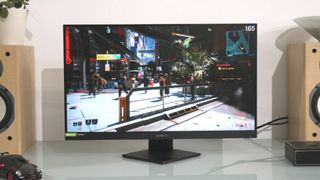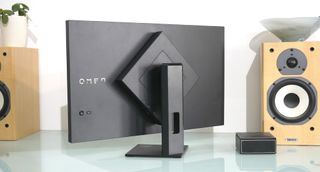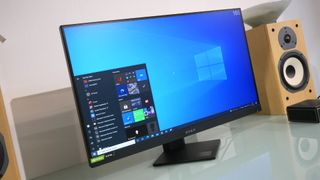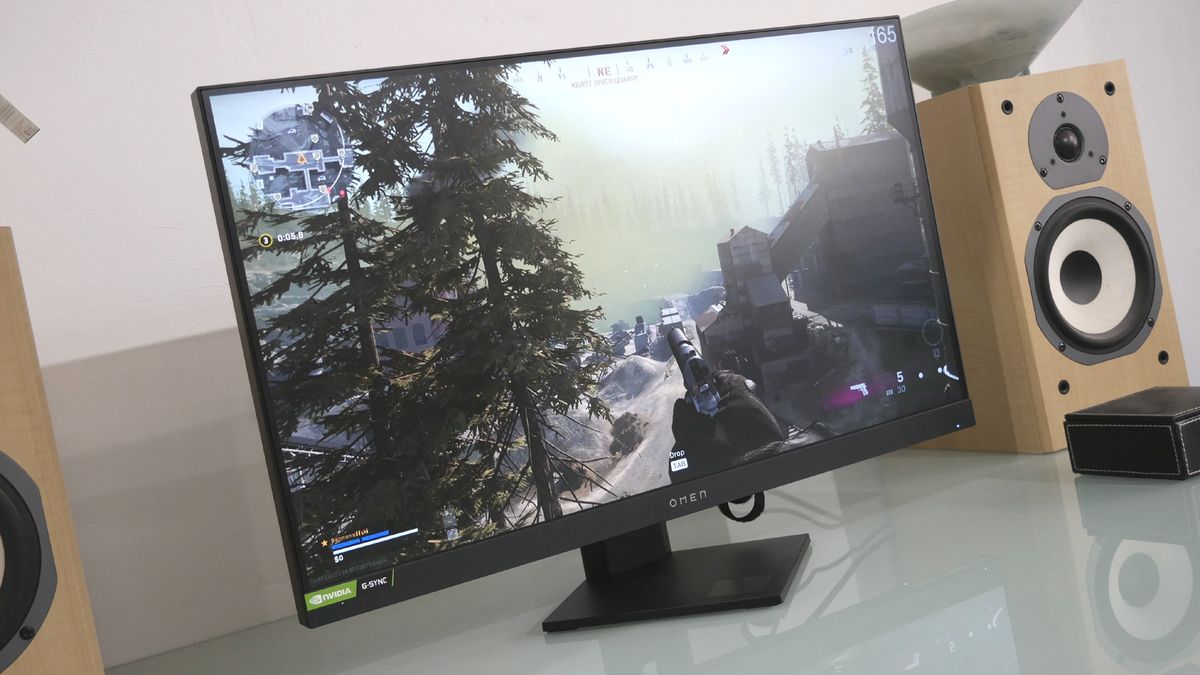Our Verdict
HP Omen’s latest 25-inch gaming monitor combines 165Hz refresh with decent if not spectacular pixel response. Just don’t expect anything special from the 1080p IPS panel in terms of image quality.
For
- Speedy 165Hz IPS panel
- Decent feature set
- Nice build quality and styling
Against
- Slightly underwhelming image quality
- Tilt-only stand
- Better displays are available at this price
PC Gamer's got your back
Got a budget of about 300 bucks to blow on a new gaming monitor or a similar sum in pounds sterling? Then you face a tricky conundrum. Could the solution be the new HP Omen 25i?
At this price point, you certainly have an embarrassment of choice. You can go for resolutions up to 4K, refresh rates north of 120Hz, all three of the major panel types (that’ll be TN, IPS and VA), G-Sync and FreeSync, various HDR implementations and, well, you get the idea. What you can’t have, of course, is everything in one panel. Not even close for this kind of money and arguably not quite at any price.
Panel size: 25-inch
Panel technology: IPS
Native resolution: 1,920 x 1,080
Aspect Ratio: 16:9
Refresh rate: 165 Hz
Response time: 1 ms (MPRT)
HDR: VESA DisplayHDR 400
Contrast: 1,000:1
Color: 90% DCI-P3
Brightness: 400 nits
Video Inputs: HDMI 2.0 x2, DisplayPort 1.4
Other: G-Sync Compatible, FreeSync Premium Pro, USB 3.0 hub
With all that in mind, HP’s latest gaming solution is built around a 25-inch 1080p IPS panel with high refresh rates, fast pixel response and at least some attention paid to image quality as opposed to purely speed.
At this budget, of course, you can have 1440p and even 4K monitors with far more pixels than the 1,920 by 1,080 on offer here and therefore far superior image detail. But not the same speed. The other obvious alternative is a TN panel with theoretically faster pixel response but poorer viewing angles, contrast, and colour accuracy.
More specifically, HP rates the Omen 25i at 165Hz for refresh while pixel response is pegged at 1ms, albeit that’s MPRT (Moving Picture Response Time) rather than grey-to-grey. Typically, 1ms MPRT equates to 2ms GTG, an early indication that the Omen 25i might not be quite as quick as the very fastest IPS gaming panels, which are good for 1ms GTG.
Further key metrics include VESA DisplayHDR 400 certification, which is entry-level HDR technology and does not include a backlight with local dimming, 400 nits of brightness and 1,000:1 contrast. As for colour accuracy, HP quotes 90% coverage of the DCI-P3 digital cinema gamut, which is novel at least in so far as many manufacturers offering panels in this segment don’t bother quoting colour coverage at all.

Anyway, if that’s all largely in line with expectations for this type of gaming panel, what about the HP Omen 25i’s physical bearing? It certainly keys right into HP Omen’s established design ethic, most obviously in the base of the stand and the section on the rear of the monitor housing the ports and connectors. Both clearly pay homage to Omen’s logo.
The HP Omen 25i is also really nicely put together and sports sleek, slim bezels on three sides of the 25-inch panel. There’s some novel engineering in the way the stand clips into the rear of the monitor, too. It’s just a pity money was spent there and not on adjustability. Tilt is the only option, not even height adjustment is provided. Speaking of connectivity, you get one HDMI and DisplayPort each, plus a two-port USB 3 hub.
But what about the stuff that matters most, namely image quality? HP has acquired VESA DisplayHDR 400 certification for the Omen 25i. That requires a brightness capability of 400 nits. But this panel never feels quite that punchy. That may be partly because white tones aren’t quite as clean and pure as the best IPS panels.
It’s a relatively minor issue and one that the human brain is particularly adept at tuning out. But it is an indication that this isn’t a truly top drawer IPS panel in terms of straight-up image fidelity, as is evidence of a little compression in darker tones in our test images. Long story short, don’t get too excited about this monitor’s HDR performance or broader static image quality. It’s not what the HP Omen 25i does best.

In game, pixel response is good but not absolutely outstanding. HP has included five levels of user-configurable overdrive, which is welcome because it means you can really fine-tune pixel response and decide for yourself how much, if any, overshoot you are willing to accept. The two fastest settings do indeed suffer a little inverse ghosting. But, again, you get to decide what compromise to settle on.
Anyway, firing up shooters like Call of Duty Warzone, Apex Legends and Fortnite, the Omen 25i feels very responsive. Subjectively, the pixel response isn’t quite as snappy as the very best IPS monitors, much less the fastest TN screens. But don’t get us wrong, the Omen 25i is no slouch.
Slightly less successful is its performance in graphics fests like Cyberpunk 2077. The colours are marginally less vibrant than the best IPS panels. There’s also a little IPS glow visible in darker tones. Again, this isn’t a bad monitor, it’s just not especially remarkable.
Factor in the relatively modest 25-inch proportions and the unspectacular 1080p native resolution and you wouldn’t pick this panel if pure visual spectacle, as opposed to response and speed, was your main priority.

Of course, that much was obvious enough on paper. Big, bolder screens can be had for similar money. What the HP Omen 25i does deliver, however, is a pretty nice combination of speed and response, combined with tolerable all-round image quality, all wrapped up in a satisfyingly aesthetic, if not hugely ergonomic, package.
It’s not an instant no brainer to stick the HP Omen 25i at the top of your shortlist. But it certainly deserves serious consideration among the many 1080p high-refresh options. Check out our guide to the best high-refresh monitors if you're in the market for a speedy screen.
HP Omen’s latest 25-inch gaming monitor combines 165Hz refresh with decent if not spectacular pixel response. Just don’t expect anything special from the 1080p IPS panel in terms of image quality.

Jeremy has been writing about technology and PCs since the 90nm Netburst era (Google it!) and enjoys nothing more than a serious dissertation on the finer points of monitor input lag and overshoot followed by a forensic examination of advanced lithography. Or maybe he just likes machines that go “ping!” He also has a thing for tennis and cars.

You don't need an RTX 5090 or a 4K monitor for gaming when you can play Snake on your monitor's subpixels. But you will need a microscope or a good macro lens

Samsung is working with a studio to 'create an immersive 3D gaming experience without the need for 3D glasses' using its fancy eyeball-tracking gaming monitor
